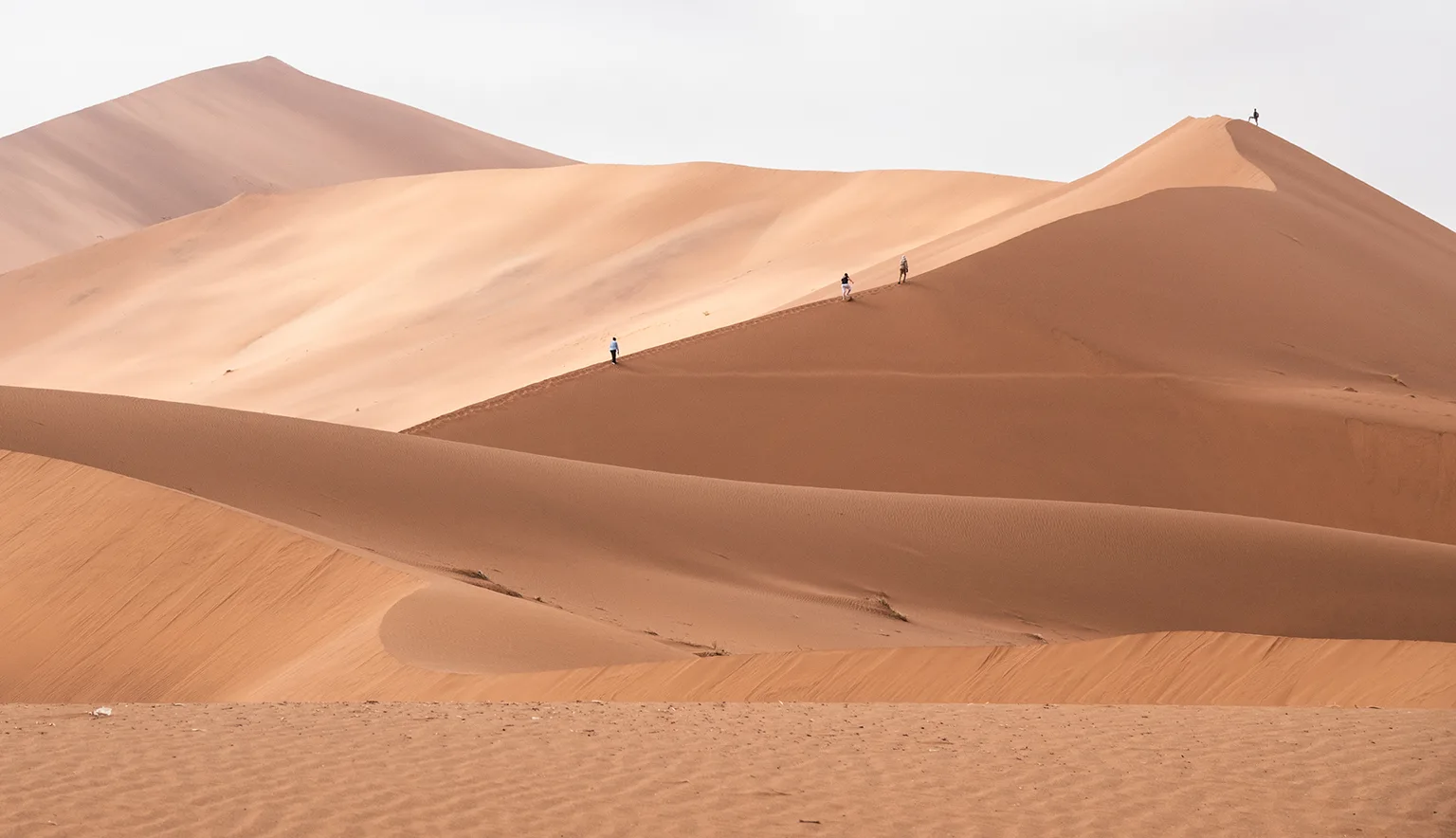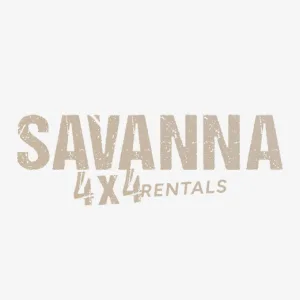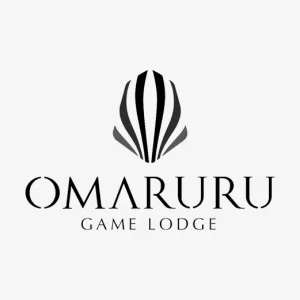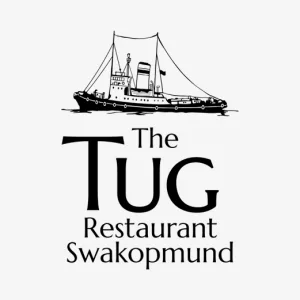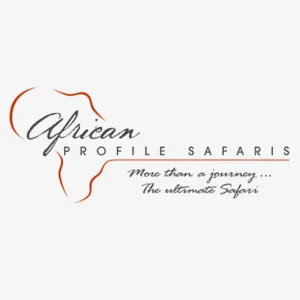With extraordinary natural beauty, diverse wildlife, and cultural richness, Namibia is Africa at its most poetic. Don your sunhat, ready your camera, and join us on a journey that will redefine your perception of paradise.
NAMIBIA
Greener, softer, slower – those travelling to Namibia should prepare to leave a part of their heart behind.
Situated on the southwest coast of Africa, the vast country is scattered with burnt-orange sand dunes that pierce the sky, endless coastlines dotted with the skeletal remains of shipwrecks, and roaming wildlife that many can only dream of seeing in person.
Namibia may be three times the size of the UK, but with a population of only three million, it is one of the most sparsely populated countries on the planet – making it a largely untouched slice of nirvana for those seeking a true sense of freedom.
With a rich cultural tapestry, the fabric of the country has been woven from the influence of Indigenous, Afrikaans, German, and other origins, making it a proud melting pot of stories and heritage. Its striking horizon, clear skies, and friendly people make it the ultimate African vacation.
Head to Sossusvlei to feel the sand of the towering red dunes shift beneath your boots, venture to Etosha Pan where lions drink from waterholes, and embark upon a journey to the Skeleton Coast for fog, solitude, and dramatic landscapes.
Travelling through Namibia is not about rushing from destination to destination; it’s about the in between. If you want a real taste of the country, forgo the checklist, drive with leisure, and let the silence do the work. Watch the morning fog clear to reveal elephant herds, hike through granite outcrops as jackals wail in a chorus, and explore the millennia-old history of the land with local guides.
With everything from rustic camping experiences under the night sky to 5-star lodges that will redefine your definition of relaxation to safaris that boast lions, giraffes, elephants, rhinos, oryx, and so many others, Namibia is a country ripe with opportunity.

Q&A WITH THE HOSPITALITY ASSOCIATION OF NAMIBIA
Founded nearly 40 years ago, the Hospitality Association of Namibia (HAN) is a trade association for the hospitality sector in the country, with its members representing every area of the industry, including hotels, guest houses, guest farms, lodges, rest camps, restaurants, conference centres, and catering services.
HAN proudly serves Namibia’s tourism sector by embodying service, excellence, respect, value, and ethics, and reflects the full diversity of the country and its myriad offerings. Its main focus is to maintain high-quality standards across hospitality establishments, ensuring visitors are able to fully experience all the nation has to celebrate.
Gitta Paetzold, CEO, expands upon the association’s origins, ambitions, and the secret treasures Namibia has waiting for those looking for a once-in-a-lifetime African adventure.
Can you talk us through the origins of HAN and its initial vision?
Gitta Paetzold, CEO (GP): HAN was founded in 1987 by 16 members, with that number today having matured to approximately 400. It represents the full spectrum of the hospitality industry because we believe that tourism is everyone’s business.
Suppliers to the industry, as well as publishers of literature and marketing companies, have also chosen to join the HAN family to unite their voices behind efforts to develop a sustainable tourism industry in Namibia.
What are your organisation’s current goals?
GP: HAN’s overall goals, or objectives, as defined by its constitution, are:
To promote the common interests of the members of the association, as well as provide them with benefits from being a member, and deal with all such matters.
To promote the sound development of the tourism industry in general, specifically the hospitality industry of Namibia.
To represent its members, whenever so required, and further promote, support, or oppose – as may be deemed expedient – any proposed legislative or other measures affecting the common interest of the members of the association.
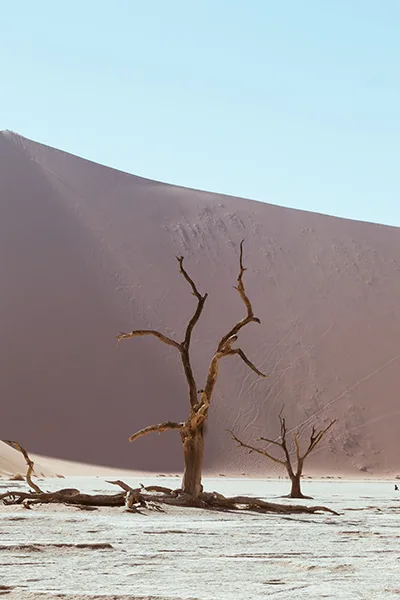
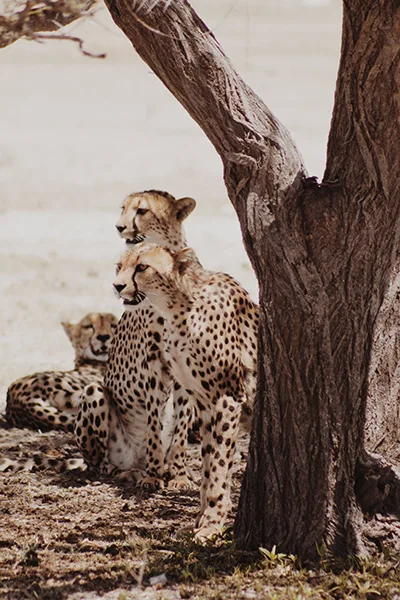
Please tell us more about HAN’s core values and what they mean to the organisation.
GM: Being in the service industry, with interpersonal focus as the key to our success in a flourishing hospitality industry, HAN played with the letters SERVE to define its core values, and listed them as such:
- Service – We exist to serve our members, and therefore, we shall not waver in our quest to promote and protect their collective interests.
- Excellence – We commit ourselves to upholding the highest possible standards and shall also pursue and expect the same level of excellence for the hospitality sector.
- Respect – We embrace people from all walks of life and value their uniqueness and contributions.
- Value – We dedicate ourselves to proactive promotion and protection of the hospitality sector through value-adding collaboration to reach its full potential.
- Ethics – We shall uphold principles of governance and integrity in all our dealings and pursue truth.
How do you market Namibia as a destination?
GM: HAN, as a non-profit voluntary organisation that advocates for the interests of its members, does not engage in active marketing activities for the country and its members directly.
However, as a key stakeholder and partner to institutions like the Namibia Tourism Board, which is Namibia’s statutory body established to both market Namibia as a travel destination of choice as well as to regulate the sector and apply quality controls, HAN acts in an advisory capacity in terms of marketing efforts, choice of destinations, and target markets.
It also advises its members on suitable events and activities to engage and participate in to ensure Namibia is represented as a desirable destination. In our efforts, we emphasise the diversity of Namibia in terms of landscapes, offerings, products, as well as the diverse cultural heritage the country offers, which makes it a unique selling point.
How do you promote off-season travel?
GM: In the past, the Namibian tourism sector was strongly seasonal, relying on the main travel period of our source markets (predominantly Western Europe) from July to September. At the time, Namibia focused on winter, which is an ideal game viewing opportunity – when it is dry and animals are prevalent at waterholes – which we believed to be the main attraction our country had to offer.
Things have changed extensively over the past decade, with our shoulder or green season from January to May offering spectacular sightings in terms of the colours of the desert, endless horizons of pastel, flowing rivers in otherwise arid outbacks, as well as seasonal cultural and gourmet experiences. From Namibia’s unique Omajova mushroom delicacy to the earthy Kalahari truffles found in some parts of East-Central Namibia after rain. It is increasingly becoming a must-taste experience that brings travellers to our country between February and May.
The green season also offers opportunities for better prices and greater availability, which has seen a shift in demand for accommodation and the ebbing out of spikes in tourism numbers throughout the year. There are a number of special offers, targeting local and Southern African Development Community (SADC) markets, but also green-season specials for international clients.
Being a long-haul destination and given the size of the country, travellers to Namibia need a certain number of days and weeks to make a journey to this southwestern part of Africa worthwhile. It is an ideal family destination, and we still depend on the Western holiday period for the bulk of our business.
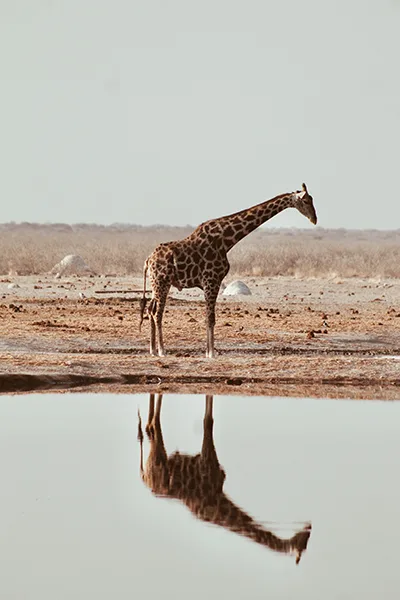
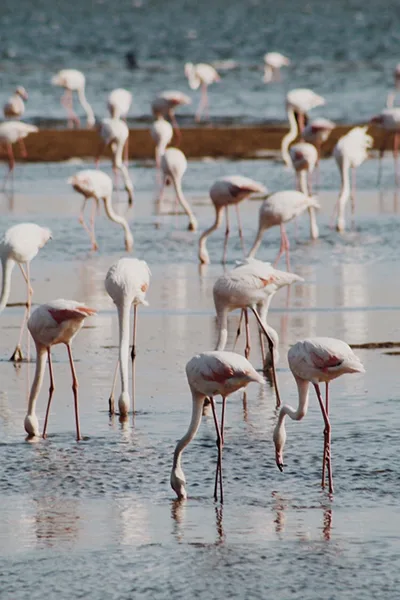
Are there any interesting projects in the pipeline you wish to highlight?
GM: A key attraction that Namibia shares with its neighbours is the Kavango-Zambezi Transfrontier Conservation Area (KAZA TFCA), the world’s largest trans-border conservation, joining the five countries of Angola, Botswana, Namibia, Zambia, and Zimbabwe. Namibia is actively promoting this region as ‘Africa’s Eden’ and, as such, continuously urges the implementation of a universal visa (uni-visa) for this region, making trans-frontier travel across borders easy and convenient.
Although Namibia is a huge country in terms of size, as one of the world’s least populated countries with just over three million people, its scope and capacity in terms of air access and hosting world events are currently limited. As a tourism sector, we are rallying behind efforts of the government through the Namibia Airports Company and the Investment Promotion and Development Board to increase air access capacity and attract more international airlines to this destination – the prospects of success look promising.
Furthermore, Namibia is actively working to establish a strong meetings, incentives, conferences, and exhibitions (MICE) market. We have a particular focus on the incentive’s component as the country, often referred to as ‘Africa light’, has well-established infrastructure in terms of roads and telecommunications, as well as a variety of venues for events. What is even more appealing is our seemingly endless potential to offer unique experiences to visitors in terms of scenery, cultural exchanges, and extreme sports activities, making it a perfect incentive destination.
Namibia is often still referred to as Africa’s best-kept secret, and whilst this title may hold some charm, HAN and the tourism sector in general are keen to shine more light on the scope of the tourism sector in Namibia. We are working on crafting an annual Tourism Market event that would allow for exposure, focus, and partnerships established both locally and internationally to reflect the full impact this sector has on Namibia’s economy and its people.
“Namibia is often still referred to as Africa’s best-kept secret, and whilst this title may hold some charm, HAN and the tourism sector in general are keen to shine more light on the scope of the tourism sector in Namibia”
Gitta Paetzold, CEO, Hospitality Association of Namibia
Why, in your opinion, should someone visit Namibia?
GM: Africa is globally accepted as the cradle of mankind – reason enough to be visited by everyone at least once in a lifetime!
We are aware that this continent may still be perceived as the ‘dark continent’, and some are hesitant to explore it. However, we in Namibia can confidently say that our country offers the perfect entry into beautiful Africa, offering a perfect mix between the developed and developing world. Namibia boasts modern water and sanitation infrastructure in key centres across the country. Equally, our cultural diversity offers a wide range of gourmet dining experiences from traditional food and local product offerings to the tasty international cuisine offered at tourism establishments by qualified chefs.
Namibia’s charm is that you have the best of both worlds. You can enjoy the comfort of modern-style city life, and within a five to 10-minute drive, immerse yourself in African bush life, far removed from the hassle and buzz of towns and nightlife.
Namibia is known to offer a soulful, liberating experience with its wide-open spaces and diverse landscapes. From the iconic Namib and Kalahari Deserts in the southwest to the wild running waters linking Kunene, the Kavango, and the Zambezi in the Northwest to the world’s largest trans-frontier conservation park, the country offers some very unique and diverse travel experiences.
“Namibia is known to offer a soulful, liberating experience with its wide-open spaces and diverse landscapes”
Gitta Paetzold, CEO, Hospitality Association of Namibia
What are some of the country’s most unique landmarks?
GM: Namibia is best known for its free-roaming wildlife as well as its large national parks. Etosha National Park in North-Central Namibia is one of the country’s key tourism flagships, as are Sossusvlei and the Deadvlei desert dune area in the south – a UNESCO World Heritage Site.
Namibia’s first UNESCO World Heritage Site is Twyfelfontein and is home to an unparalleled number of San rock engravings. This rock forms a coherent, extensive, and high-quality record of ritual practices relating to hunter-gather communities in this part of Southern Africa, spanning at least two millennia. It is reflective of Namibia’s rich cultural history and heritage – a geologist’s or archaeologist’s dream.
Furthermore, Namibia is known as the country where the desert meets the sea, where the wild, cold Atlantic meets the vast hinterland of orange sand dunes in the Namib Desert.
It also shares one of the world’s best wildlife recovery stories ever told. Namibia’s conservation and community tourism programmes offer an ideal platform to immerse and engage in authentic cultural experiences, alongside witnessing some of the traditional nomadic lifestyles and cultures of some of Namibia’s 14 different ethnic groups, most of whom have maintained their lifestyles and traditions over centuries and are proud to share their stories with guests.
What trends are transforming the tourism industry in Namibia, and how are you utilising them?
GM: Namibia is part of the fast-evolving globe, and as much as we would like to offer our visitors the chance to detach and unwind, we are aware of the need for connectivity and speed. As such, the tourism sector is committed to providing connectivity in terms of its business operations and booking processes, offering travellers a link to home and the outside world.
Namibia also offers a variety of travel styles, including guided coach tours and a compilation of flexible individual traveller (FIT) tours, as well as the independent ‘self-drive tourist’ – a market segment that currently dominates the Namibian tourism industry.
This is possible through well-established infrastructure and booking portals providing direct access to the multitude of offerings to travellers from all parts of the globe. With large parts of Namibia’s attractions based in rural areas, its accommodation offerings span the full spectrum of high-end exclusive lodges, tented facilities, glamping, camping, and self-catering, making the country a truly accessible travel destination to suit any taste.
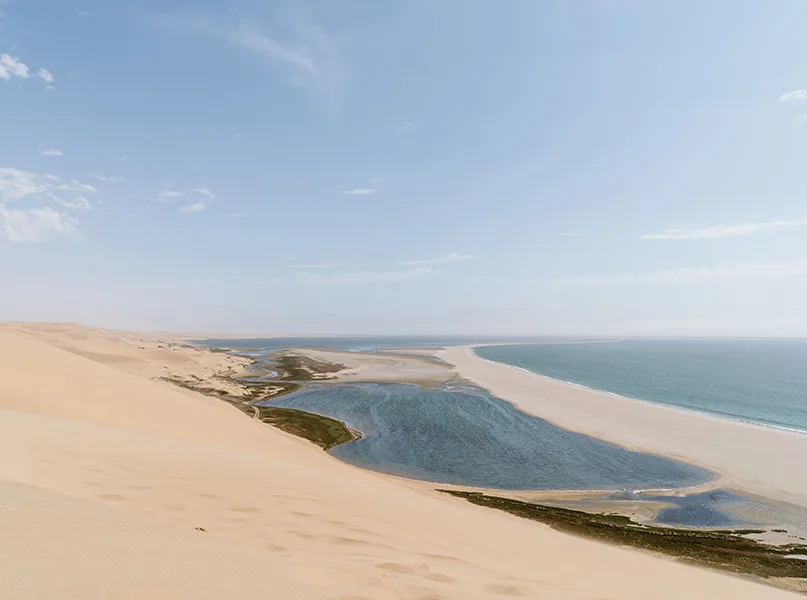
What challenges does the tourist industry in Namibia face?
GM: Given its location, Namibia is a long-haul destination for most of our key tourism markets. As such, air access remains our key challenge.
Post-COVID-19, and with the closure of our national airline, Air Namibia, the country has yet to see the return of an acceptable number of international airlines to service the route between this part of Southern Africa and Europe – let alone the Americas and Asia. Therefore, our potential for growth is currently hampered by a lack of air access, both in terms of numbers and costs of flights, given the near monopoly that current airlines connecting Namibia hold.
We are happy to note that Edelweiss, part of the Lufthansa Group, recently announced the introduction of twice-weekly direct flights between Zurich and Windhoek in the European high season – June to October – starting in summer 2026.
Furthermore, in a country where the traditional economy has been dominated by mining, fishing, and agriculture, tourism is yet to enjoy full recognition by its people and decision-makers in terms of the impact it makes, not only financially, but in terms of job creation, livelihoods, and community development. An active debate has started to ensure balance is maintained between sustainable development, land use, and conservation.
Namibia shares the global challenge of attracting suitable talent and skills to this industry, as tourism is seldom chosen as an ideal career path by youth.
As such, in 2023, HAN committed to the establishment of a Tourism Training Roadmap to document and showcase the potential this sector has in terms of job creation, entrepreneurship, and livelihoods for communities in remote areas where there is little chance of any other income, but offer the kind of pristine, unique environments travellers and locals want to experience.
Are you optimistic about the future of the tourism industry in Namibia?
GM: Definitely, as tourism may be the country’s only truly sustainable economic sector ever if developed and managed sustainably. Given the foundation and key pillars upon which the Namibian tourism model is based – namely the environment, conservation, wildlife, and its people – it may hold the golden key for sustainability and long-term economic profitability in Namibia, with the tri-pod of people, planet, and profitability strongly established to cook up a tasty, vibrant, and unique tourism experience for all to enjoy.
TWYFELFONTEIN IN FOCUS
Step back in time and explore a life-altering destination where traces of humanity from eons ago can be witnessed first-hand.
LOCATED 100 KILOMETRES (km) from the sea, where the scenery shifts from the dry red sands of the Namib Desert to the lush waving grasslands of Damaraland, lies a valley that stretches across the sandstone plateau. It is within this valley that Twyfelfontein – Namibia’s first UNESCO World Heritage Site – is situated.
Renowned for being home to one of the largest single groupings of ancient engraved images in Southern Africa, Twyfelfontein’s ancient rock engravings – or petroglyphs – comprise approximately 2,500 individual paintings and engravings. These historic images were created by the San or Bushmen people, who lived in South Africa centuries ago in different hunter-fisher-gatherer societies and depict various scenes, including hunting, animals, and geometric patterns.
Specifically, the remaining motifs comprise antelopes, zebras, giraffes, lions, ostriches, and even seals – showcasing the global interactions and travels the people of that era embarked upon. The site is one of the most coherent, extensive, and high-quality records of such ritualistic practices relating to communities from between 2,000 and 10,000 years ago, eloquently bringing to life the connection between the ritual and economic practices of the age.
The name Twyfelfontein roughly translates to ‘fountain of doubt’ in Afrikaans. It stems from topographer David Levin, who resided in the area with his family and cattle in the mid-20th century and had doubts about the capacity of the spring that ran through the valley, leading a local farmer to nickname him Twyfelfontein – a name which then stuck to the land.
The valley was declared a national monument in 1952 and a UNESCO World Heritage Site in 2007. Today, it can only be visited with a designated local guide in order to ensure the protection and longevity of the culturally significant engravings, which provide a uniquely preserved looking glass that transports visitors back in time.
NAMIB SAND SEA IN FOCUS
Widely considered the oldest desert on Earth and one of the largest in Africa, the Namib Sand Sea has an astonishing history of aridity that extends back between 55 and 80 million years. Stretching hundreds of miles along the Atlantic Ocean, the otherworldly desert emerges like a surreal oasis of towering sand dunes and ever-shifting shadows that cast vivid colours as the sun travels across the sky.
The red-hued wonderland is both an incredible example of the evolution of a one-of-a-kind desert landscape and a sanctuary for wildlife that have uniquely adapted to the extensive environment.
Part of the reason the Namib Sand Sea is so exceptionally beautiful and distinctive is its status as an active geological-geomorphological phenomenon. This is due, in part, to fog being the primary source of water across the three million hectares of desert. Various species have learned to thrive in the hostile environment by taking advantage of the fog-bathed coastal dunes and developing ways to trap the atmospheric water that blankets the landscape. The endemic plants and animals residing within the sands are a globally important example of evolution and the ability of life to prosper in extreme environments.
The desert was declared a UNESCO World Heritage Site in 2013 and is a haven for adventure-seekers and nature-lovers alike who are looking for a truly inspiring and unparalleled experience in the heart of the country’s natural wilderness.
OUTLOOK RECEOMMENDS
Sleep:
FOR A NEW DIMENSION IN NAMIBIAN TRAVEL…
Quiver & Co offers travellers the opportunity to feel the warmth and excitement of an unforgettable and authentic Namibian experience in one of its many stunning lodges. Inspired by intimate knowledge of the country’s natural wonders and a desire to share a love of hospitality, Quiver & Co ensures each guest experiences a genuine and passionate Namibian stay.
FOR AN OASIS-LIKE EXPERIENCE…
Omaruru Game Lodge is a private safari stay nestled in the heart of Namibia that has built a reputation over the past 30 years for its stunning natural beauty and unique wildlife encounters. Offering a perfect blend of tranquillity and adventure, the lodge is synonymous with comfort and seclusion.
Upon arrival, you will experience a uniquely designed wildlife reserve environment steeped in traditional architecture and complete with stylishly furnished bungalows. The lodge is home to elephants, rhinos, antelope, oryx, and many more, allowing guests to be led by experienced guides and observe wildlife in their natural habitats.
FOR A LUXURY SAFARI STAY…
An adventure that starts where the road ends, Kifaru Luxury Lodge and Bush Camp (Kifaru) offers guests an opportunity to immerse themselves in utter tranquillity.

Standing proudly on the beautifully weathered landscape of Namibia, Kifaru is so much more than just a stunning accommodation; it is a safari paradise.
With the name Kifaru meaning ‘rhino’ in Swahili, the conservation of the critically endangered animals is at the heart of the lodge’s ethos. A majority of the revenue generated by the lodge goes towards the Rhino Momma Project – an organisation dedicated to the care and repopulation of the species in Southern Africa.

The Kifaru reserve boasts over 60 different species of mammals and more than 300 species of birds. Visitors can explore the generous landscape on foot or via 4×4, with each experience carefully crafted to ensure the highest standards of safety and enjoyment. Feel the magic of the Namibian Bushveld as you learn more about the remarkably unique ecosystem whilst making memories for years to come.
With only six rooms on the property, travellers should expect nothing less than luxury and exclusivity at the lodge. For a more easy-going, adventurous experience, guests can stay at the rustic Kifaru Bush Camp located 5km from the main luxury lodge. Don’t forget to take advantage of the infinity pool that overlooks the floodlit waterhole, allowing you to enjoy watching myriad animals whilst sipping a cocktail or taking a refreshing dip.
Kifaru is more than just an overnight stop; it is a destination where you can linger and an adventure to embrace.
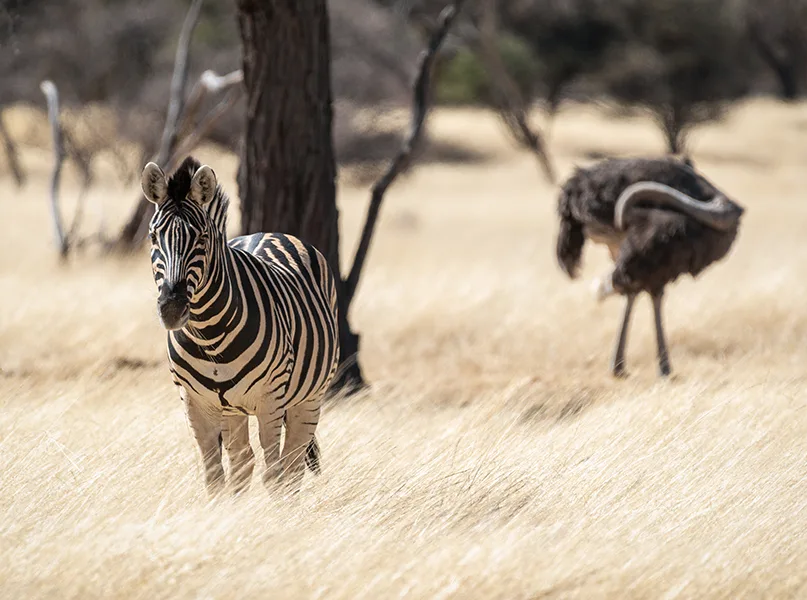
Eat:
FOR A RUSTIC YET AUTHENTIC DINING EXPERIENCE…
A shining pearl of warm Namibian hospitality, The Tug Restaurant is a location like no other that needs to be experienced firsthand. Embark on a culinary journey where each meal is renowned for its home-made freshness, locally sourced seafood, fresh produce, mouthwatering desserts, and tantalising South African wines.
Serving customers with unforgettable dishes for over 30 years, the restaurant has situated itself as a unique experience, expertly blending the region’s maritime history with modern culinary adventure. As a beloved spot for both locals and visitors, The Tug Restaurant offers a truly special dining experience with breathtaking ocean views.
FOR A RESTAURANT WHERE FOOD MEETS CULTURE…
Xwama Traditional Restaurant, based in Katutura, Windhoek, is a gateway to authentic Namibian gastronomy and living. Created with the aim of sharing real Namibian food and traditions, every recipe the restaurant serves carries stories passed down through generations.
When you enter, you’re immediately met with an authentic Namibian homestead. Stone walls, a thatched roof, wooden supports, and a top floor with genuine sand flooring all create a traditional ambience that only adds to the restaurant’s atmosphere.
With local markets supplying fresh ingredients daily, each dish is rich and a nod to the local environment. With the combination of home-style cooking, genuine setting, and knowledgeable staff, Xwama Traditional Restaurant is the place to visit for a real Namibian experience.
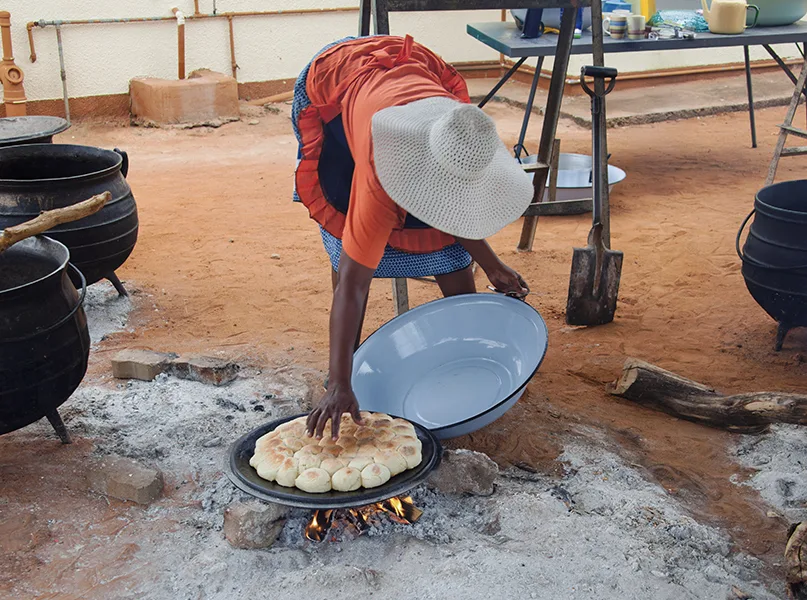
LANDMARK ATTRACTIONS
Kavango-Zambezi Transfrontier Conservation Area
The Kavango-Zambezi Transfrontier Conservation Area (KAZA TFCA) is one of the largest in Africa, spanning five southern countries and offering incredible biodiversity and the chance to encounter wildlife up close in their natural environment. Visitors can see elephants, lions, rhinos, and more in vast, unspoilt wilderness, making KAZA TFCA a must-see for wildlife enthusiasts and those interested in cross-border conservation efforts. The area covers savanna, grassland, dry, and moist woodland biomes, merging to create a distinctly rich ecosystem.
Sossusvlei
Located in the Namib-Naukluft National Park, Sossusvlei is renowned for its majestic red sand dunes, boasting some of the tallest in the world, such as the Big Daddy dune (325 metres). The area also features striking landscapes, including Deadvlei, with its ancient dead camel throne trees set against contrasting white clay pans and vivid dunes. Sossusvlei is a haven for photographers, hikers, and those enthralled by desert-adapted flora and fauna.
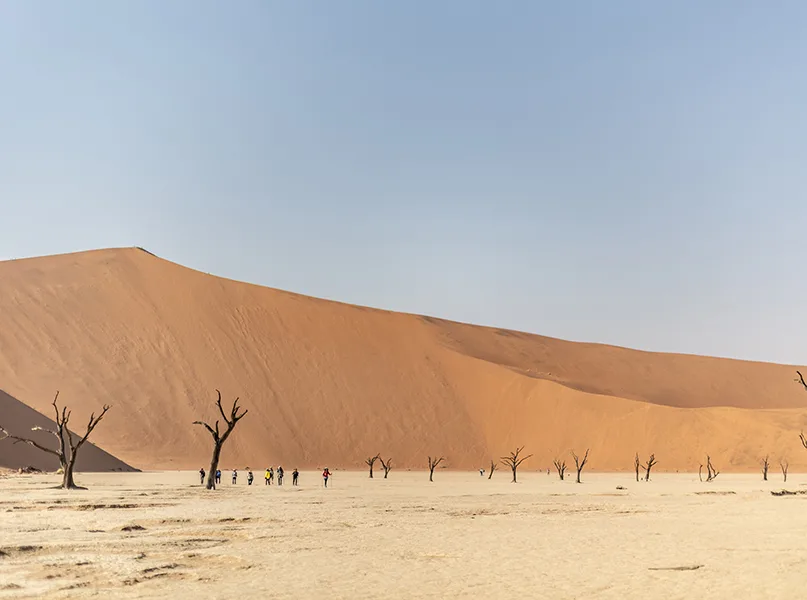
Skeleton Coast
The Skeleton Coast is a remote and rugged stretch of shoreline in Northwest Namibia, known for its shipwrecks, dense fog, and stark beauty. Where the Namib Desert meets the Atlantic Ocean, the coast is characterised by shifting sands, rocky shores, and dramatic landscapes. Equally, the destination is famous for its unique wildlife and the remnants of historical shipwrecks and whale bones.
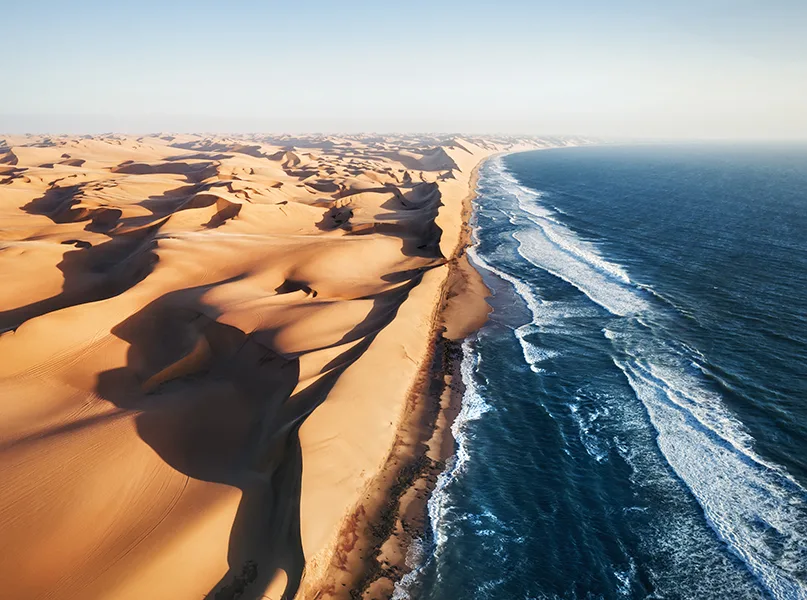
GETTING THERE AND AROUND
Flying into Namibia is the most traditional way of getting to the country; however, there are very few direct flights into Hosea Kutako International Airport (WDH), located 45km east of the capital city of Windhoek. Therefore, most international travellers should expect at least a layover or two before arriving.
Companies such as British Airways and Virgin Atlantic have regular flights from London Heathrow Airport (LHR) to OR Tambo International Airport in Johannesburg (JNB), which then makes it a quick hop from the city into Namibia. Virgin Atlantic even has an alliance with South African Airways, making it easy to book the two flights together.
Whilst many may think that booking a flight is the most important part of a trip, in Namibia, securing a car is undoubtedly even more crucial. Driving around the vast country isn’t just a mode of transport – it’s part of the trip itself. Full of long drives, empty roads, and ample scenery that encourages every visitor to stop, admire, and breathe it all in, the country is designed for slow travel. Ideally, a 4×4 is the best rental option to traverse between destinations, as many of the most memorable views and experiences are off the beaten path.
With wide open roads, endless skies, and landscapes that seem otherworldly, Namibia’s beauty is in the silence, space, and journey between destinations.
There is no best time to visit the country, as each season has its own offerings and highlights to bask in. The dry season from May to October is traditionally the most popular season, as the days are long and sunny, the skies are blue, and countless animals of all shapes and sizes gather around waterholes.
June to August is peak safari season, with cool nights and striking landscapes. November to April is the summer wet season, and whilst you may get stuck in a rainstorm or two, it is the best time to witness the landscapes turn green, baby animals emerge into the world, and the local birdlife explode in hypnotic song.
Ultimately, the best time of the year to visit is entirely dependent upon the type of holiday you wish to have. Whether that be chasing wildlife, cool evenings beneath dazzling stars, or eerie and empty landscapes, Namibia is truly a destination of dreams.


